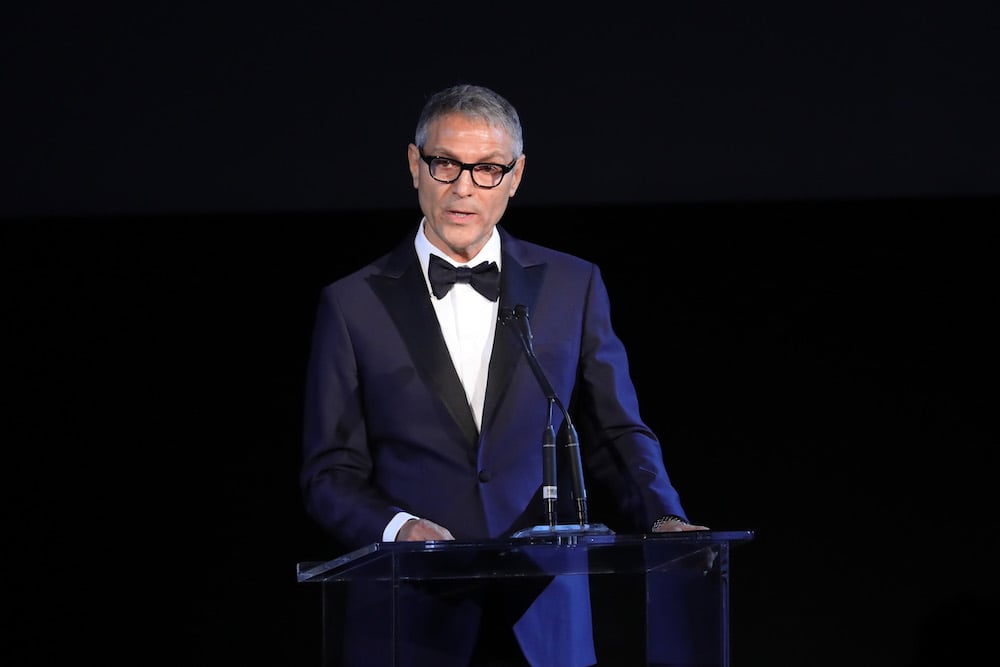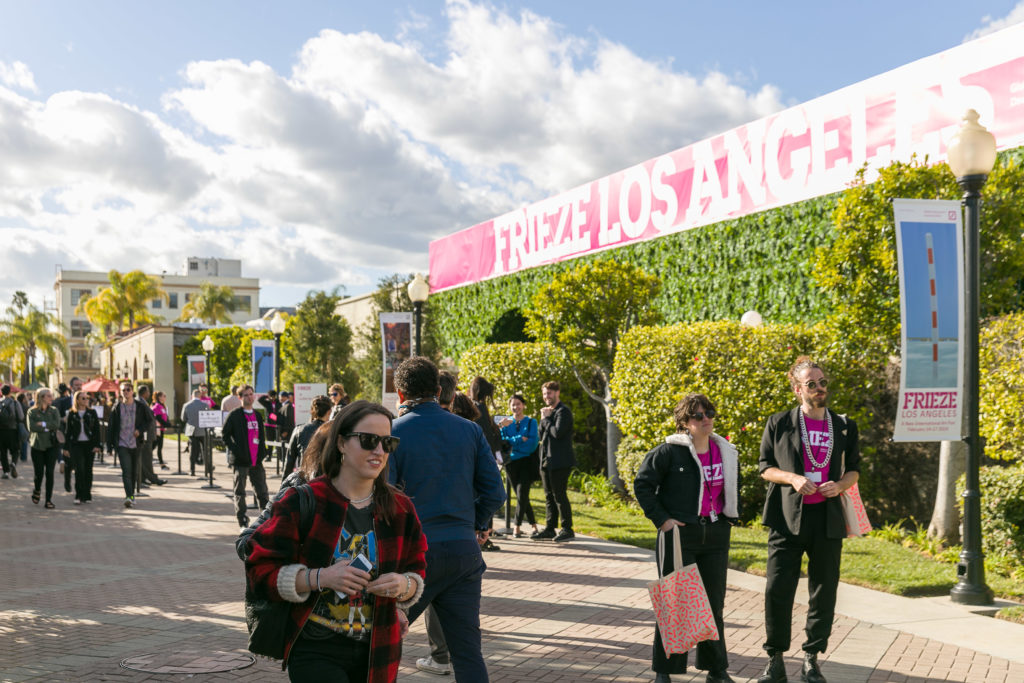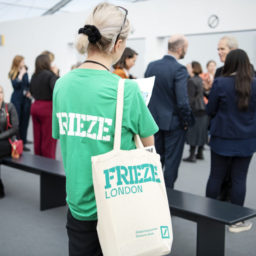Although the interplay between the private and public markets always matters in the art trade, it has been an especially noteworthy topic in recent months. First came the news in mid-June that Sotheby’s had reached an agreement in principle to return to private ownership thanks to a $3.7 billion sale to international telecom impresario Patrick Drahi. But just as one well-known art brand leaves the New York Stock Exchange, another intends to enter it.
The Frieze art-fair and publishing company was due to effectively go public on Friday as a small piece of the initial public offering of its majority owner, entertainment and media conglomerate Endeavor. (Update: After the close of trading on Thursday, Endeavor announced it would postpone its IPO for the second time this year. No future timeline for the offering was made available.) And just as we asked how Sotheby’s exit from the public market might affect its business, it is now worth asking how Endeavor’s availability on the NYSE could affect Frieze.
Filed September 16, the most recent substantive amendment to Endeavor’s registration with the Securities and Exchange Commission states that the company will offer over 19.3 million shares of Class A common stock priced between $30 and $32 each. The offering could infuse Endeavor with over $619 million. It also represents a 7.9 percent ownership stake, meaning Endeavor enters the public market with a valuation of about $7.6 billion—more than twice the price Drahi will pay for Sotheby’s. (Update: Between this piece’s publication and the eventual postponement of the IPO, Endeavor filed a new amendment lowering the number of shares on offer to 15 million and the price range to between $26 and $27 per share. The changes reduced its maximum possible return on the offering to $405 million and its market cap to about $6.5 billion.)
Frieze, however, comprises only a thin sliver of Endeavor’s overall business. The amended registration (known as an S-1 filing) confirms what has been known for some time: that Endeavor acquired a 70 percent stake in Frieze’s parent company, Denmark Street Limited, in April 2016. The same month, Endeavor also bought Fusion Marketing (later rebranded as “Fusion/IMG Live”), billed as an experiential live events and marketing firm, in its entirety. The S-1 states that these two acquisitions cost Endeavor a combined $89.3 million, split between cash and assumption of debts and liabilities.
The further accounting details on both properties are blended as if Frieze and Fusion were a single entity. Together, they ended the 2016 fiscal year with consolidated revenue of $106 million—for perspective, about $5 million shy of the sale price of Claude Monet’s Meules (1890) at Sotheby’s New York this May—and net income of $3.6 million. How much of those totals comes from Frieze alone is something that only Endeavor’s accountants and underwriters know.

Endeavor co-founder and WME co-CEO Ari Emanuel speaks onstage during the 2017 LACMA Art + Film Gala honoring Mark Bradford and George Lucas, presented by Gucci at LACMA. (Photo by Neilson Barnard/Getty Images for LACMA)
Crystal Balling
The rest of the filing provides a few details worth keeping in mind vis-à-vis Frieze’s future. Endeavor uses much of its prospectus to pitch itself as a “platform” for aggressive growth achievable by integrating the talent represented by its agencies (WME and IMG) with its various properties, as well as leveraging those properties and their underlying infrastructures into new markets both domestically and internationally.
Frieze is described in the S-1 as an “owned asset” within the event-management department of Endeavor’s “content platform.” This designation aligns Frieze with the likes of the Ultimate Fighting Championship (UFC) mixed-martial arts brand, the Miami Open tennis tournament, and the Professional Bull Riders league, among other properties in which it has acquired either a majority or minority stake. Through this segment of its portfolio, Endeavor claims to already own and/or operate over 700 global events per year.
But the company wants more. Under a section of the filing labeled “Growth Strategies,” Endeavor states that it “envision[s] demand for our clients and owned assets will continue to grow in markets around the world and therefore aim[s] to improve and increase access and activation opportunities… particularly in certain large media markets such as China and Russia.” The company cites last year’s inaugural Frieze Los Angeles fair among its successful efforts to geographically expand its owned assets—a process it believes it can “efficiently scale” going forward thanks to its “existing global sales and distribution infrastructure.”
In other words, expect Frieze to consider planting its flag in more new territories in the coming years. The bigger question may be whether it seeks to do so through additional fairs, or through alternative projects like Frieze South Bronx, its exploratory (and ultimately shelved) plan for a 280-acre arts district in the borough’s Port Morris area.
But arguably the largest unknown of all concerns who will chart Frieze’s course beyond next year.
The S-1 verifies that, as part of Endeavor’s deal to acquire its 70 percent stake in Frieze, co-founders Amanda Sharp and Matthew Slotover retained an option to sell their remaining 30 percent of the brand to Endeavor at the end of the 2020 fiscal year. The flip side is that Endeavor likewise maintains an option to buy out Sharp and Slotover at the same point in time, or else upon their termination. (The filing notes that the duo “continued to be employees of Frieze after the acquisition.”)
In either case, the option price would be based on the previous year’s EBITDA (earnings before interest, taxes, depreciation, and amortization) multiplied by 7.5, a figure projected in the S-1 to be $16.4 million in the 2017 fiscal year and $15.9 million in 2018.
The exact parameters of Sharp and Slotover’s involvement with Frieze past 2020, including whether they could stay in their roles with or without retaining an ownership stake of some size, remain unclear. An Endeavor representative declined to answer artnet News’s questions about the option agreement, saying only that the S-1 provides legally required disclosures. But a source with direct knowledge of the situation confirmed that Sharp and Slotover maintain day-to-day control over the brand despite their status as minority shareholders—and will continue to at least through next year.

On the Paramount Studios lot at Frieze Los Angeles 2019. Photo by Mark Blower. Image courtesy of Mark Blower/Frieze.
The Big Picture
When trying to parse Frieze’s future prospects, Endeavor’s stated plans may be less useful than watching how public investors respond to the IPO, as well as how the stock trades going forward. A sizable cash infusion will be necessary to fund its ambitious strategy; so far, neither the company’s fundamentals nor many outside analysts have made an especially optimistic case.
Perhaps the brightest warning light is Endeavor’s debt load. In the S-1 filing, the company reported approximately $7.2 billion in total liabilities as of June 30, 2019, versus revenue of just above $2 billion over the same period. With less than $1 billion in cash at the same juncture, Endeavor faces plenty of questions about how it will narrow that financial gap, and how soon.
This is almost undoubtedly one reason that Endeavor states that the company does not expect to pay any dividends or other distributions on its Class A shares “in the foreseeable future.” Instead, it will retain its future earnings, most likely to pay down debt and/or acquisition deals. This aspect alone may turn off many potential investors. Buyers’ resistance could be worsened, as well, by the company’s decision to adopt a Silicon-Valley-style dual-class stock structure that effectively grants the top brass at Endeavor and its major private investors the power to control the company in perpetuity.
Also of concern is the actual amount of synergy between Endeavor’s various properties, regardless of the quality of its underlying sales and distribution infrastructure. While the company’s language around expansion and economies of scale sounds compelling, it’s worth asking, for instance, how many more quality art fairs (a historically low-margin business) it can realistically produce annually, or how much growth can really be generated through integrating the respective infrastructure and audiences for Frieze Masters and, say, the Professional Bull Riders’ Helldorado Days competition? Is the company fundraising through an IPO because it merely needs to extend the timeline so that economies of scale can take root, or is it pivoting to the public markets because its private investors are unsatisfied with the strategy’s projected returns otherwise? Also, are China and Russia really the goldmines of growth that Endeavor says, or minefields?
And even as Endeavor touts the high-value promotional possibilities of the many film, music, and sports stars represented by its core agency, WME, it will surprise no one in the art world to hear that representing artists of any kind is a turbulent business.

303 Gallery’s booth at Frieze Los Angeles 2019. Photo by Mark Blower. Image courtesy of Mark Blower/Frieze.
Case in point: since the spring, WME and its entertainment-agency rivals have been locked in an existential struggle with the Writers Guild of America (WGA), the labor union for writers of film, television, news programming, documentaries, animation, and new media. The guild advised its more than 7,000 members to fire their agents en masse in April to protest what they deemed unfair and unlawful practices surrounding so-called packaging fees, alleging that the agencies have been short-changing their literary clients for years in order to line their own pockets and benefit outside investors. (Full disclosure: My brother is a WGA member.)
Even after losing a large swathe of its writing talent, Endeavor still boasts over 6,000 clients under management across various entertainment and media sectors. However, Cynthia Littleton and Gene Madaus note in Variety that the IPO could make several of those clients anxious that their career concerns may disappear inside Endeavor’s cross-platform, world-conquering vision—a feeling that would make them ripe for poaching. As an unnamed agent at a WME competitor told them, “Anyone who thinks we aren’t in a free-for-all right now doesn’t know agents.”
In the end, the ultimate question is whether even flawless execution of Endeavor’s strategy would find favor with the average day trader or mutual-fund manager. As Littleton and Maddaus write of Endeavor, “It can be difficult to explain the largesse and uniqueness of the agency business to investors scrutinizing a profit-and-loss statement.” Exchange the word “agency” for the word “auction” or “art,” and the sentence could just as easily describe the challenges faced by Sotheby’s during its 31 years on the New York Stock Exchange. No matter what dreams ownership—meaning Endeavor, Sharp, and Slotover collectively—may have for Frieze in the years ahead, its future will soon be plotted just as much by the cold reality of how the marketplace reacts to its offering of shares at $32 or less. Time will tell whether that road leads to greater heights than it did for the world’s oldest auction house.












